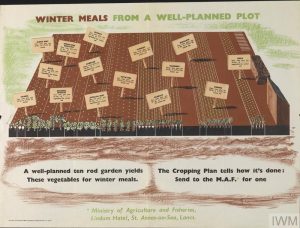
One of the problems Britain faced during WWII was the lack in availability of rations. The line at the grocers was long and some people would end up with nothing, so the idea of “dig for victory” came about. Digging for victory was meant to persuade people to plant their own vegetables, thereby cutting unproductive wait times with the chance to feed the family all year long. (As shown here).
The poster was made in Great Britain by Mary Tunbridge, and was published by both “Her Majesty’s Stationary Office” and the “Ministry of Agriculture and Fisheries”. The responsibilities of the Ministry of Agriculture and Fisheries include food and farming, such as CAP (Common Agricultural Policy), apprenticeships, exports, and bovine TB (tuberculosis) policy, fisheries, better regulation and science and innovation (gov.uk). During the early 1920’s the ministry started off as a small department, but it had its work cut out. By the 1930’s the ministry not only supported agriculture within the nation, but farmer’s income as well. By World War II, the ministry became the one and only “buyer and importer of food and regulated prices”.
The actual poster itself is described by the IWM as, “the image is placed in a central position with text, in black, in the top left and top right. Red text is positioned underneath and all is set against a plain white background. image: rear view of a small boy wearing a white hat, white shorts and white shirt. He is holding a spade in his right hand and a hoe in his left, and is walking towards the diffuse blue background. The ground appears to be dry and cracked”. This poster does not stand on its own and is actually one of many, designed by the Ministry of Agriculture as a part of the “Dig For Victory” campaign. The purpose of this poster/campaign was to encourage civilians to plant their own crops which would not only help to feed the nation, but ultimately “decrease Britain’s reliance on imports”, especially those that resided in homefront because they were threatened with starvation caused by the German U- Boat blockade. (telegraph.co.uk)
A plethora of posters in favor of the “Dig for Victory” campaign was released, some of which are shown below.
 This particular image conveys how the campaign also aimed to “free up valuable space for war materials on the merchant shipping convoys”. (homesweethomefront.co.uk)
This particular image conveys how the campaign also aimed to “free up valuable space for war materials on the merchant shipping convoys”. (homesweethomefront.co.uk)
In addition to single posters, some posters also came with their own characters and slogans:

“Here’s the man who ploughs the fields.
Here’s the girl who lifts up the yield.
Here’s the man who deals with the clamp, so that millions of jaws can chew and champ.
That’s the story and here’s the star,
Potato Pete
eat up,
ta ta!”
These characters not only helped in the instance of propaganda, but made their way into daily life. Potato Pete for example, became a part of both recipe books and nursery rhymes.
So, was the “Dig For Victory” campaign effective? It sure was. According to The Telegraph, “nearly 1.4 million allotments in Britain by the end of the war, which produced 1.3m tonnes of produce”. These posters helped to halve food imports by 1941 and by 1942 half the nations population was “digging for victory”.










Melissa Dinsman
Some great connections made in this blog post. I love the inclusion of Potato Pete! Why do you think there was so much emphasis on the potato itself? And why do you think the poster is geared toward children?
Saudia Haniff
Thank you! I think there was so much emphasis on the potato itself because potatoes can be grown in Britain, that way they wouldn’t have to depend on imports. As for why it’s geared towards children, I suspect it’s because they want kids to become familiar with these things from a young age, so when they get older they too will want to “dig for victory”.